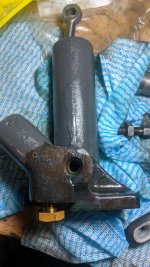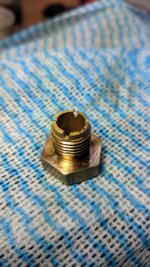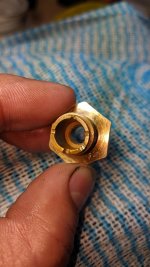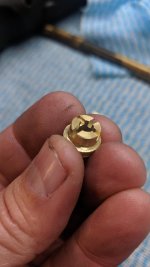StrayAlien
Cast Iron
- Joined
- Aug 18, 2014
- Location
- Melbourne, Australia
Hi all,
Seeking help in some reparations here.
I am in the process of bringing a Hercus power hacksaw back to life - I think it has been beyond use for many years and it is amazing that is has not yet seen the scrapper . Made in Australia and likely some time between 1938-1945 or so. This old girl::

The ram lifter mechanism does not work and I suspect some part(s) were missing when I got it. It is a very simple machine so I am figuring/hoping Hercus likely just copied or used a similar mechanism to other hacksaws of the period.
The lifter is to raise the ram on the non-cutting stroke during operation, but also it has to permit manual lifting of the ram for workpiece placement plus gradual lowering to the workpiece and also during cutting.
I'm only allowed 5 pics here so this initial post might go into the next post so I get get some pics in.




The unit is driven from an eccentric on the main shaft. It has two cylinders joined by channel. The small cylinder piston is attached to the shaft eccentric. The large cylinder piston is attached to the ram. Both pistons are plain - no rings or such. It has a brass 'valve' (?) thingo at the base. The small cylinder appears to have a bleed hole or something about half way up. The brass 'valve' appears to have some small holes or something at the top.
The hole in the 'valve' is pretty big. Way too big to permit any hydraulic action on the big piston - oil just goes in and out of the hole and the big piston never moves. I've tried oils ISO 68 up to ISO 140 differential oil. No joy.
I've tried quite a few experiments including the obvious 'put a ball bearing in the valve'. But this permit *no* oil to escape so if you raise the ram - it doesn't lower. "but what about the bleed hole on the small cylinder" - well, it seems to be always obscured by the piston. Even all full 'extension' with the small piston as far out as it will go - including all adjustibility, that hole is still covered. So .. no oil out.
The holes in the top of the 'valve' seem functional - like that are supposed to hold something in .. or something sat on top and oil bled through these holes underneath it. Dunno.
Anybody know how a unit like this is supposed to wok? It is driving me nuts!
All help appreciated,
Greg.
Seeking help in some reparations here.
I am in the process of bringing a Hercus power hacksaw back to life - I think it has been beyond use for many years and it is amazing that is has not yet seen the scrapper . Made in Australia and likely some time between 1938-1945 or so. This old girl::

The ram lifter mechanism does not work and I suspect some part(s) were missing when I got it. It is a very simple machine so I am figuring/hoping Hercus likely just copied or used a similar mechanism to other hacksaws of the period.
The lifter is to raise the ram on the non-cutting stroke during operation, but also it has to permit manual lifting of the ram for workpiece placement plus gradual lowering to the workpiece and also during cutting.
I'm only allowed 5 pics here so this initial post might go into the next post so I get get some pics in.




The unit is driven from an eccentric on the main shaft. It has two cylinders joined by channel. The small cylinder piston is attached to the shaft eccentric. The large cylinder piston is attached to the ram. Both pistons are plain - no rings or such. It has a brass 'valve' (?) thingo at the base. The small cylinder appears to have a bleed hole or something about half way up. The brass 'valve' appears to have some small holes or something at the top.
The hole in the 'valve' is pretty big. Way too big to permit any hydraulic action on the big piston - oil just goes in and out of the hole and the big piston never moves. I've tried oils ISO 68 up to ISO 140 differential oil. No joy.
I've tried quite a few experiments including the obvious 'put a ball bearing in the valve'. But this permit *no* oil to escape so if you raise the ram - it doesn't lower. "but what about the bleed hole on the small cylinder" - well, it seems to be always obscured by the piston. Even all full 'extension' with the small piston as far out as it will go - including all adjustibility, that hole is still covered. So .. no oil out.
The holes in the top of the 'valve' seem functional - like that are supposed to hold something in .. or something sat on top and oil bled through these holes underneath it. Dunno.
Anybody know how a unit like this is supposed to wok? It is driving me nuts!
All help appreciated,
Greg.




